Best Solar Water Heater in 2023 – Save Money, Reduce Carbon Footprint
Any primary school science student knows that it takes a lot of energy to warm up water. Unfortunately, the sun doesn’t always shine brightly enough to maintain comfortable temperatures in your swimming pool. By installing a high-quality solar water heater, however, you can capture the sun’s rays for concentrated hot water production year-round.
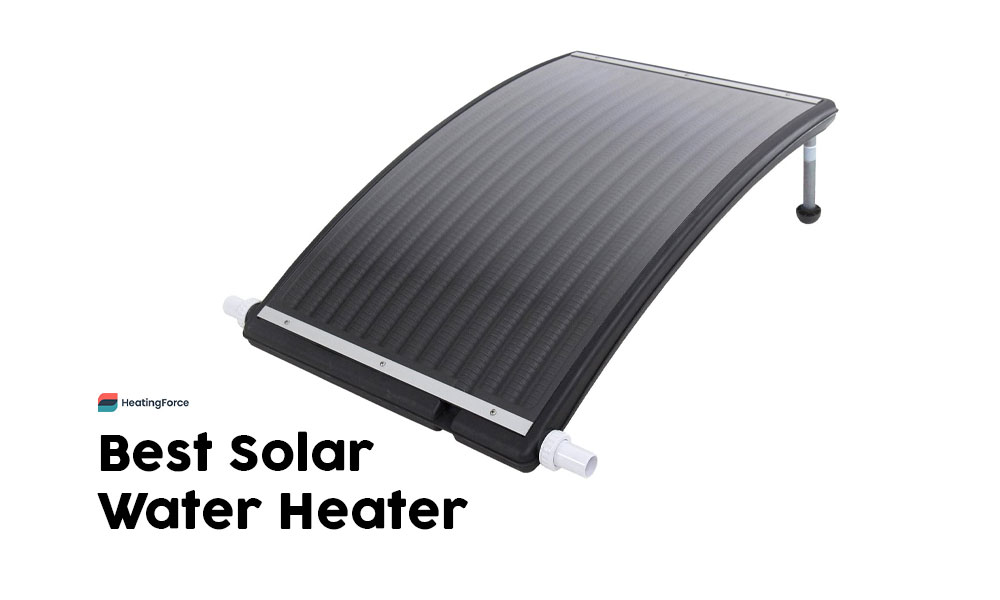
If you’re ready to extend pool season and save money on your monthly energy bill, read on. Below, we review the five best passive solar collectors currently on the market. You’ll also learn about what you can do to maximise your solar water heater’s efficiency, plus how to expand your existing system’s capacity with solar panels and batteries.
Best passive solar water heater
Once upon a time, solar technology was expensive, and consumer solar products served niche applications. Nowadays, green technology is in vogue. Moreover, solar is considered an economically and ecologically viable option for even the average home owner.
Here below, we present five of the best passive solar water heaters for any pool or budget. You can use them alone, or purchase multiples and install them in series for greater heat output. Each also makes an energy-efficient complement to homes with existing solar panels and electric pool heaters.
1. Steinbach Speedsolar Collector
Most solar pool heaters require a considerable investment of space in your valuable yard space, but not the Speedsolar Collector from German manufacturer Steinbach. Measuring just 14 x 110 x 69 cm, the Speedsolar is defined by its graceful arched design which packs more solar collection in a smaller space.
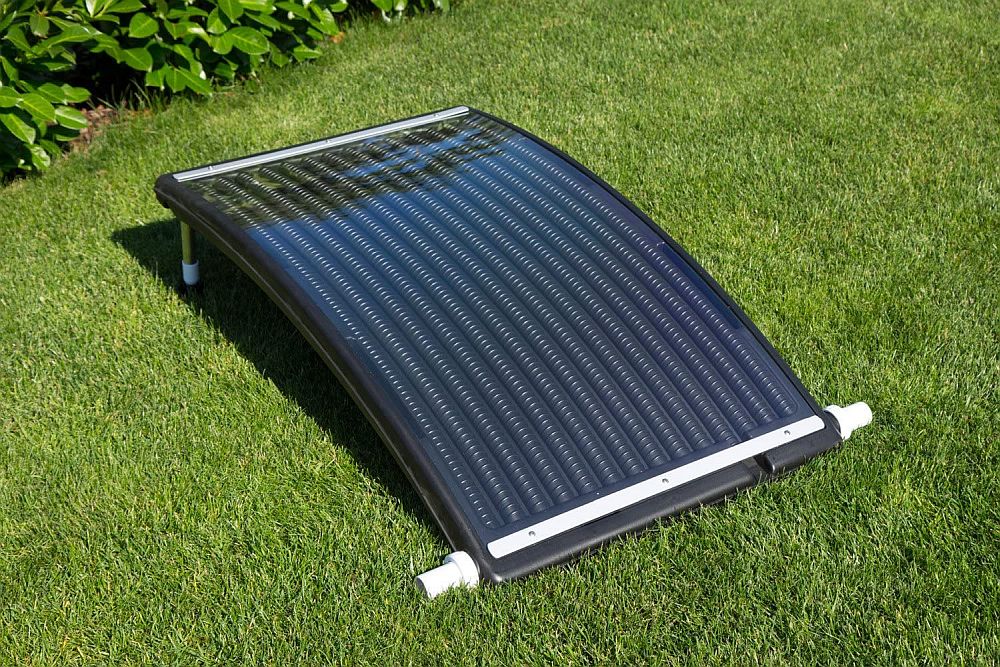
Got uneven ground, or need to compensate the angle for optimal positioning within the sun’s rays? Extend the rugged, built-in supports with rubberised feet to achieve the perfect adjustment.
Despite its small footprint, the Speedsolar has a water capacity of up to 15L. Depending on the size of your pool, you’ll find a single unit is sufficient to raise water temperatures 1-2°. If you need more heating, Steinbach makes it easy to daisy chain collectors together; simply run a short Ø 38mm connecting hose between each additional unit, then let the sun do the rest!
The collectors are made of high-density polyethylene (HDPE), while the dome is made of UV-resisting polycarbonate. This combination will allow your Speedsolar to withstand the sun’s powerful rays whilst effectively harnessing them to your luxurious benefit.
Steinbach’s Speedsolar is compatible with all standard pool pumps, and works best warming above-ground pools. In the box, you’ll find everything you need to get your solar water heater installed fast, including the collector, hose, connection nozzle, and sealing ring. Steinbach were even kind enough to throw in some Teflon tape to make your life that much easier.
Pros:
- Easily positioned on the ground or leaning against a wall thanks to its rigid, arched design
- Save valuable yard space
- Good workmanship
Cons:
- As this is a smaller unit, multiple collectors are usually required to effectively heat larger pools
- Included screw fittings are a bit finicky, and require some elbow grease to tighten properly
2. MISOL 10 Evacuated Tube Solar Collector
MISOL offers a different take on the traditional passive solar water collectors. Rather than using black-finished HDPE coils which absorb the sun’s energy and transfer it directly to the water within, their 10 Evacuated Tube system is more sophisticated.
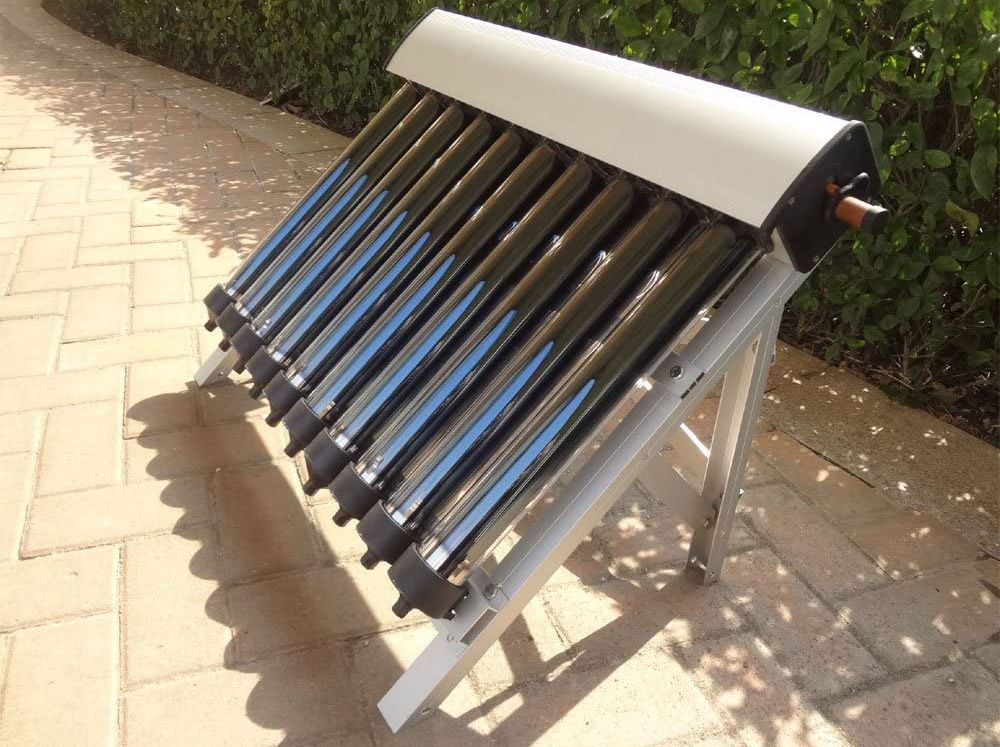
The term “evacuated” isn’t just a marketing gimmick; it refers to the fact that each of those tubes does indeed contain a vacuum within. MISOL uses layers of high-boron, high-silicon glass to create this vacuum space, then stuffs rock wool in between. The result is an effective laminate of thermal insulation, which utterly traps heat absorbed by the sun within.
Nested within this system is a copper pipe which contains the water to be heated and subsequently sent to your pool. And, there’s a special aluminium nitride heat transfer strip, which dramatically speeds up thermal conduction within the copper water pipe.
When summed together, your MISOL 10 Evacuated offers a more efficient and effective way to warm your pool. What’s more, with a tough frame made of aluminium, and dust-proof EPDM rubber fittings and bushings, your solar water heater will stand up well to intense UV radiation and continue to function optimally for years to come.
Pros:
- Space- and cost-efficient way to warm water using solar energy
- Highly durable design
- Useful for both pools and small home heating systems
Cons:
- As the system is fairly complex, pre-assembled shipping is not possible
- No instructions included
3. LWQ Solar Heater
If you’re looking for a larger-scale solar water heating solution, the LWQ Solar Heater is a solid choice. At 70 x 600cm, there’s plenty of surface area to collect ample energy from the sun for effective warming of even large-sized pools. As with many high-quality solar collectors, you can daisy chain multiple LWQ units together for even more heat output.
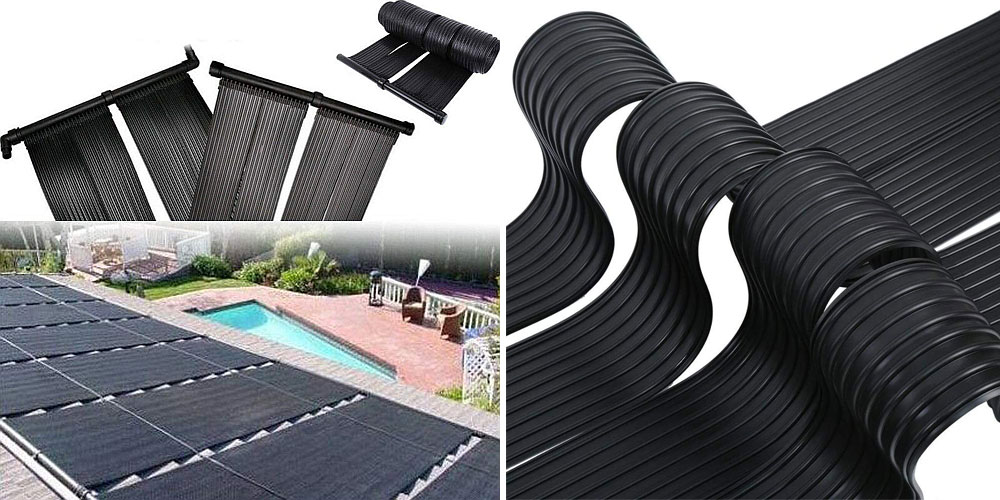
The LWQ Solar Heater consists of a combination of plastic and EPDM. The result is a flexible solar system which is at once thermally efficient and durable vs. both UV rays and ozone cracking.
Due to its expansive area, the LWQ Solar Heater is best positioned on your roof, where it can make optimal use of its size to collect the maximum amount of solar energy. If you can spare the lawn space, laying it out flat on the ground is also a viable option, as is mounting it upon a rattan frame. Whatever you choose, it won’t be a tough job, as it’s extra lightweight and features quick-connect installation.
While the LWQ Solar Heater is on the higher end in terms of price, it easily justifies its cost by the sheer amount of heat it delivers. What’s more, the money you save with an electrical heater makes not only for cheaper monthly power bills, but contributes to a greener, healthier planet overall.
Pros:
- Eco-friendly heating for medium-large sized pools
- Extremely lightweight yet durable for long-term roof mounting
- Resistant to degradation
Cons:
- Large surface area may not be viable on all properties
- Expensive
- Adapters (like backflow valve) not included
4. AquaForte Pond Basin Solar Heater
In stark contrast to the previous entry on our list of the best solar water heaters, we arrive at the compact AquaForte Pond Basin heater. When space is at an absolute premium around your pool, these compact collectors pack a real punch.

Housed safe within a UV-resistant polycarbonate dome, you’ll find an extensive length of solar collector coil. These are ridged to increase the surface area by which solar energy is absorbed, then transferred to the water within. Beneath these coils is a high-polish reflective dish, which ensures that any sun not collected upon entry is shone again upon the rear of the pipes.
There’s nothing high-tech about AquaForte’s design, it’s just a smart way to game physical science to get lots heating out of a small unit. And small it is indeed, with a footprint just under four square feet. The dome has a rise of about half its width, so be sure to account for this when positioning the AquaForte amongst your landscaping.
While there’s plenty to praise with the efficacy of this unit, in all honesty a single AquaForte will not be enough to raise a medium-sized pool more than a single degree. That’s why we typically recommend you spring for two units, which you can install in series for several times the heat output.
Pros:
- Clever domed design offers ample surface area while saving space in your yard
- Durable polycarbonate dome protects plastic collector from UV rays and physical deterioration
- Affordable, compact solar collectors lend themselves to daisy chaining for more heat
Cons:
- Small footprint comes at a compromise to total heat output, all but requiring multiple units for meaningful heating of medium-sized pools or larger
- Manual only comes in Dutch (wat jammer!)
5. Intex Solar Heating Mat
Intex’s simply-named Solar Heating Mat is the final recommendation on our list, but it is by no means the least. If you’ve got a pool with a capacity of 30,000L or less, you’ll be hard-pressed to find more value for money than with Intex.
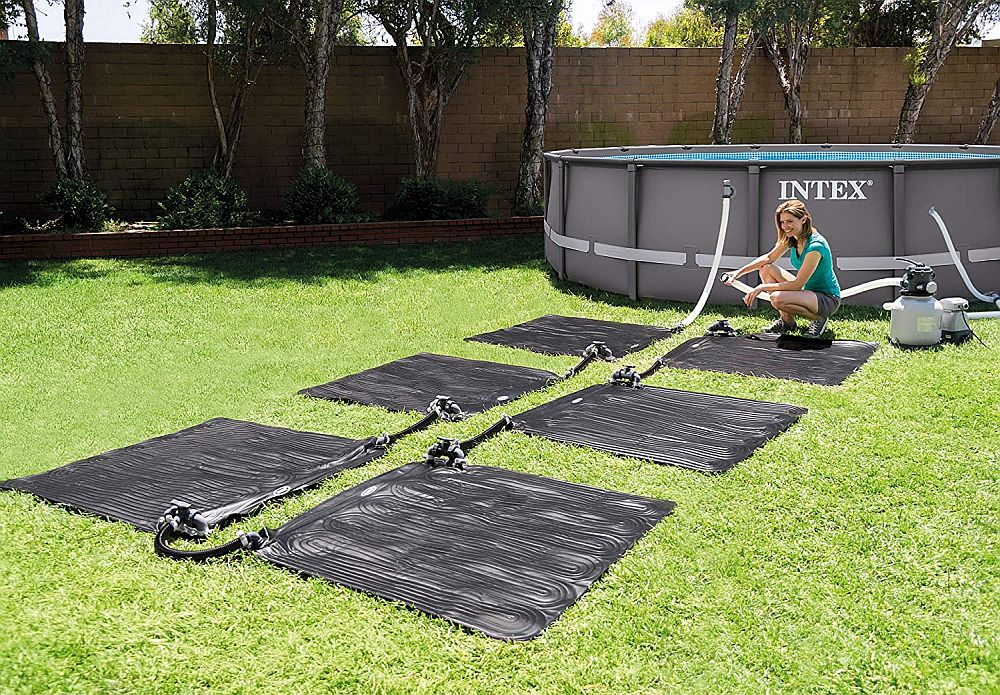
The Solar Heating Mat features a 1 square metre heat-absorbing area. However, this increases up to 44% when filled with water, giving you even more heating power. For medium-sized above-ground pools, you can expect effective temperature rises between 3-5°, depending on the weather.
While it lacks advanced protection vs. UV radiation and ozone, you’ll find the heavy duty PVC construction amply durable to serve you throughout the year. At 2.9kg, the Intex is extremely manageable, and lends itself to easy positioning wherever you need it. It also drains easily, allowing you to easily pack it up during months where the pool won’t be in use.
Intex makes for easy installation, including a 32mm hose plus adaptors for 38mm hoses in the box. So long as your pump filter features a flow rate under 7,500L/hr (or 2,000 gal/hr), you can attach the Solar Heating Mat as simply as plugging in inlet and outlet hoses via bypass valve (not included). As with our other recommended solar collectors, you can combine multiple Intex units in series to heat bigger pools.
Overall, at well under £100, The Intex Solar Heating Mat does much to justify your modest investment. Not only does it render effective heating, it does so without spiking your power meter or taking up an excessive amount of space on your property.
Pros:
- Extremely affordable for great heating
- Easy to install
- Modest footprint
- Eco-friendly
Cons:
- Price point demands compromise between performance and long-term durability, favouring the former
How do solar water heaters work?
They say nothing in life is free, but that’s not quite true when it comes to solar water heaters. Sure, you need to pay for the unit upfront, but once you’ve got it set up, it produces warmth without drawing on your power bill. (Or indeed, without costing you anything at all!) No, it’s not magic, and truth be told it’s not even high technology–it’s mankind’s oldest source of warmth, the inexhaustible sun.
If you’ve ever left a smoothie out in the sun, only to come back to an unpalatable, melted slop, you already intuitively understand how solar water heaters work. Commercial units, however, maximise the transfer of the sun’s rays into a body of water through clever design.
The basic design
The typical solar collector comprises of an extensive length of black plastic or HDPE tubing, therein containing a high volume of water. This long, water-filled coil is almost always black, which as your primary school science teacher will remind you, is best at absorbing light and therefore, heat. What’s more, the coil will wrap in around itself many times, and typically feature some sort of ridging to maximise surface area by which even more solar energy may be absorbed.
So, your pool pump forces water through this long heating chamber, and it comes out the other side full of heat, where it conducts into the rest of your pool. The beautiful thing about this system is that it happens continually, so long as the sun is out and shining. And really, solar water heaters truly are just this simple in general.
Variants
Of course, there are some variations on this design. For instance, some units deploy a reflector beneath the coils, which reflects any sun not absorbed on the first pass back up to the collector. This essentially makes the sun shine twice as strong upon the coils, and produces a higher level of heat in a shorter amount of time.
Other systems feature expandable coils, which greatly increases the available surface area for solar absorption when filled with water. This not only boosts heat output, but conserves on floor space if your yard is smaller.
There are also solar water heaters which make use of a type of vacuum tube. This is a bit more complicated, but it’s extremely effective; essentially you deploy an array of these tubes, which have a dual layer of insulation that allows heat in, but doesn’t let it back out. The heat thus gets trapped inside this chamber, heating up the copper water conduit that lays inside. While copper is a good heat conductor, these pipes will usually have a strip of material which is even more thermally conductive to speed up the transfer of heat further.
From there, the water flows back out to your pool to heat it up, just like a standard plastic-coil solar water heater does.
Tips for getting the most out of your solar water heater
So now it’s clear that solar water heaters make use of simple physics to deliver heat to your pool. However, there are a few things you must keep in mind to ensure that your chosen unit does performs the best it can. Here’s a short buyer’s guide to make your life easier:
Prevent loss of pool heat
Solar water heaters work great when it’s sunny outside, but what about at night, or when it’s cloudy? Obviously, in the absence of the sun’s radiation, your solar collector will not have the ability to continue heating your pool.
So, with neither the sun nor your heater available to provide constant heat input, your pool will start to cool off. This is primarily due to evaporation, in which highly energised water particles turn to vapour and carry heat out of and away from your pool. Not only does the mean colder water, but it also means your solar water heater will have to work harder to regain the lost degrees the next day.
But you can retain the majority of your pool’s heat by simply covering it when it’s not in use. Not only does this keep your pool nice and clean, but it traps in heat and prevents water from evaporating away. It’s a low-tech solution that will greatly increase the efficiency of your solar water heater!
Beware of advertised performance figures
There’s a dirty secret of the passive solar pool heater industry. And that is that there’s no 100% fool-proof way to guarantee how much an individual unit can raise the temperature of your pool per day. Here’s why:
- Pools vary greatly in size and design, and thus how much heat they require and how well they retain it are massive variables
- Equally, your location has a huge impact on how well your solar water heater works; more sun equals more heat, and vice versa
- Finally, while your water heater will do a lot of work to warm your pool, so too will the sun itself, shining upon the water’s surface itself!
With these variables in mind, it takes some fairly heavy calculation to determine the absolute output of your solar water heater. Manufacturer’s cannot even begin to individually account for the various use-cases their products will occupy, and thus tend to throw up the most general of numbers.
We recommend you pay special attention to reviews from people who live near you, and who own similar sized pools to your own. They’ll let you know whether a single solar collector was enough for the job, or whether additional units were necessary.
Keep longevity in mind
It’s easy to think that because solar water heaters don’t have any fragile electrical components or moving parts, they’re fairly immune to breakage and maintenance. And, for the most part, a well-built collector will indeed live up to this reputation. Nevertheless, wear and tear can still happen in a few key ways:
UV damage
Laying out in the sun on a Spanish holiday is a great way to get a tan, but too much exposure leads to sunburn and skin damage. So, too, is the case for your solar water heater, though it has much higher tolerances than your body. Prolonged exposure to UV radiation will break down the plastic and rubber parts of your heater, so even in the best of cases there is a definite shelf life for most units.
Higher quality plastics and EPDM fittings will greatly enhance the longevity of your solar water heater, however. What’s more, many units feature polycarbonate shielding, which naturally filters out close to 100% UVA/UVB rays (it’s the same material used in many commercial safety glasses), without losing out on any of the sun’s warmth.
Ozone degradation
Less well-known is the interaction of the common atmospheric gas ozone and plastic. While the physics behind the chemical reaction is beyond the scope of this article, suffice it to say ozone can eat away at your collector coils, leading to leaks and poor heating over time.
While there’s no good way to control the ozone in the air around your property, you can select solar water heaters made of HDPE (high-density polyethylene). This material is highly resistant to the corrosive effects of ozone, and will offer a much longer service life.
Alternatively, and additionally, you can search out collectors which are enclosed within an airtight casing, greatly reducing the exposure of your vulnerable plastic and rubber bits to ozone.
Physical damage and warping
Most devices break with enough impact force, and your solar water heater is no exception. While HDPE is a fairly sturdy substance, it won’t withstand excessive physical abuse. Of course, you’ll need to be especially careful to avoid puncturing softer plastic or rubberised collectors. Make sure you position your heater in a place that isn’t in the way of foot traffic, and which can avoid falling debris from trees, rocks, and other landscaping.
But this on its own isn’t enough to ensure your solar water heater avoids physical damage. We’ve already touched upon UV and ozone damage, though it also bears mention that these deleterious forces can lead to warping on poor-quality collectors. When your heater becomes misshapen, it can lower the ability to absorb heat, and introduce leaks as piping no longer fits fast. That’s why it’s doubly important to ensure your selected heater is constructed of wear-resistant materials, or else has some sort of shielding.
Are passive solar heaters the only way to warm up your pool?
People often choose passive solar collectors for their simplicity and cost-efficiency. They typically don’t require specialist installation, and work well enough for moderate warming without impacting your monthly power bill.
However, these systems have nowhere to store the energy they collect besides your pool. As such, you’ll find that during prolonged periods of cloudiness or cooler weather, you’ll lack a way to effectively heat your pool. Every solar heating system has its advantages and disadvantages; here’s what you can do to supplement your passive collector:
Consider solar panels and batteries for your home
You probably don’t need us to introduce you to solar panels, as the UK continues to aggressively strive for carbon-neutral energy sources in pursuit of a green economy. Widespread public interest supported by government subsidy has fostered a great deal of innovation in the solar industry, driving prices down across the board.
So, it’s not news that solar panels can help lower your monthly power bill and reduce your yearly greenhouse emissions. But how can it help warm your pool? The answer is simple: storage.
Unlike passive systems, you can store the energy you collect from the sun via solar panels into batteries in the form of electric charge. You can then draw upon this later as needed, allowing you to enjoy modern miracles such as warm pool water in the late fall or even winter!
Sure, the upfront investment is higher than that of a passive solar water system, as you’ll need to buy the panels, battery, electric pool water heater, then pay for professional installation. But the upside is, this green energy system isn’t a one-trick pony; battery-backed solar panels will warm your pool, power your electric tea kettle, run the aircon in the summer, and keep you toasty safe throughout the winter. And, they do it all whilst lowering your monthly power bill!
How much do solar panels cost?
Prices for solar panels are dropping all the time. In 2020, UK residents have seen prices as low as £6,000 for a medium-sized home! Of course, there’s no one-size-fits-all solution; your costs will vary depending on how much energy you need out of your solar system, how efficient you need them to be, how big your roof is, where you live, etc.
If you’re interested in upgrading your home to meet the demands of the 21st century, get your free solar installation quote here. Solar Guide are trusted industry experts, who will help you assess your requirements, and provide the most cost-effective options available.
Wrapping up
The solar industry is booming; there are myriad solutions available to meet both your budget and your need for warm pool water the year ‘round. Today, we reviewed the top five solar water heaters on the market. We also discussed how to make the most of your new pool warming system.
Though these passive heaters provide exceptional heat for money, they function primarily when the sun is shining strong. For a more robust pool warming system that works all year, you can combine your passive collectors with electric water heaters. And these you can rig to draw power from batteries fuelled by solar panels.
Sure, such a system entails a larger initial investment. But prices are falling all the time as innovation and investment across the solar industry soar. What’s more, the long-term savings will end up paying you back many times over. You’ll also feel good about living in luxury with your perfectly warmed pool, knowing that it didn’t come at the expense of the environment.
